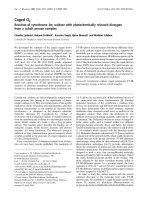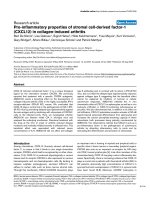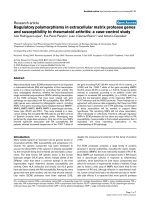Báo cáo y học: " Late pulmonary metastases of renal cell carcinoma immediately after post-transplantation immunosuppressive treatment: a case report" pps
Bạn đang xem bản rút gọn của tài liệu. Xem và tải ngay bản đầy đủ của tài liệu tại đây (252.66 KB, 5 trang )
BioMed Central
Page 1 of 5
(page number not for citation purposes)
Journal of Medical Case Reports
Open Access
Case report
Late pulmonary metastases of renal cell carcinoma immediately
after post-transplantation immunosuppressive treatment: a case
report
Jose Manuel Cozar
1
, Natalia Aptsiauri
2
, Miguel Tallada
1
, Federico Garrido
2
and Francisco Ruiz-Cabello*
2
Address:
1
Servicio de Urología, Hospital Universitario Virgen de las Nieves, Granada, Spain and
2
Servicio de Análisis Clínicos, Hospital
Universitario Virgen de las Nieves, Granada, Spain
Email: Jose Manuel Cozar - ; Natalia Aptsiauri - ;
Miguel Tallada - ; Federico Garrido - ; Francisco Ruiz-
Cabello* -
* Corresponding author
Abstract
Introduction: We report a case of pulmonary metastatic recurrence of renal adenocarcinoma
soon after radical nephrectomy that was followed by renal transplant and immunosuppressive
medication. Increased risk of metastatic recurrence of renal cell carcinoma should be considered
in the immediate post-transplant period when immunosuppressive medication is administered,
even if nephrectomy had been performed many years earlier.
Case presentation: In 1986 the patient demonstrated renal insufficiency secondary to mesangial
glomerulonephritis. In 1992 he underwent left side radical nephrectomy with histopathological
diagnosis of clear cell adenocarcinoma. Mesangial glomerulonephritis in the remaining right kidney
progressed to end-stage renal failure. In October 2000 he received a kidney transplant from a
cadaver and commenced immunosuppressive medication. Two months later, several nodules were
found in his lungs, which were identified as metastases from the primary renal tumor that had been
removed with the diseased kidney 8 years earlier.
Conclusion: Recurrence of renal cell carcinoma metastases points to tumor dormancy and
reflects a misbalance between effective tumor immune surveillance and immune escape. This case
demonstrates that a state of tumor dormancy can be interrupted soon after administration of
immunosuppressant medication.
Introduction
Renal cell carcinoma (RCC) is the most common renal
malignancy [1]. Late recurrence of metastatic renal carci-
noma has previously been described [2-5]. The greatest
risk of recurrence for RCC occurs within the first 5 years
after nephrectomy [6]. Although, recurrences have been
reported as late as 30 years following nephrectomy, rates
of 43% in the first year, 70% within the second year, 80%
within 3 years, and 93% within 5 years have been reported
[7,8]. After nephrectomy, the incidence of RCC recurrence
has been reported to be 7% with a median time of 38
months for T1 tumors, 26% with a median time of 32
Published: 18 April 2008
Journal of Medical Case Reports 2008, 2:111 doi:10.1186/1752-1947-2-111
Received: 4 September 2007
Accepted: 18 April 2008
This article is available from: />© 2008 Cozar et al; licensee BioMed Central Ltd.
This is an Open Access article distributed under the terms of the Creative Commons Attribution License ( />),
which permits unrestricted use, distribution, and reproduction in any medium, provided the original work is properly cited.
Journal of Medical Case Reports 2008, 2:111 />Page 2 of 5
(page number not for citation purposes)
months for T2 disease, and 39% with a median time to
recurrence of 17 months for T3 tumors [9]. RCC has been
shown to metastasize to almost all soft tissues in the body,
but most commonly to the lung, followed by bone, liver,
brain, and local recurrence [10]. RCC metastases occur fre-
quently in the lung, affecting 3% to 16% of patients after
nephrectomy [8,9,11].
It is well known that patients who have undergone solid
organ transplantation and are taking immune suppressing
drugs to prevent organ rejection are at a higher risk of get-
ting cancer [12]. The most common malignancies are lym-
phoproliferative disorders (early after transplantation)
and skin carcinomas (later after transplantation). In kid-
ney transplant recipients, renal cell carcinoma (RCC) may
occur either in the native kidney or, less frequently, in the
grafted kidney [13,14]. High risk of metastatic recurrence
in immunosupressed patients is often associated with
interruption of tumor dormancy and proliferation of
residual tumor cells that had survived the anti-tumor
immune reactivity because of low immunogenicity
[15,16]. Cancer patients with tumor dormancy can have
an apparent balance between tumor cell replication and
cell death, reflecting a balance between effective immune
surveillance and immune escape [17].
Here we report a case of late and aggressive pulmonary
metastatic progression of renal cancer in an immunosu-
pressed patient soon after renal transplantation and many
years after the initial removal of a malignant kidney. We
believe that immunosuppressive medication provoked
rapid metastatic recurrence in this patient.
Case presentation
A 43-year-old male patient with a previous history of arte-
rial hypertension and cholecystectomy for gallstone dis-
ease, presented in our clinic in 1986 with renal
insufficiency secondary to mesangial glomerulonephritis
and without any evidence of a renal mass as analyzed by
sonography. In 1992, a renal mass on the left side, com-
patible with renal adenocarcinoma, was detected during a
surveillance annual abdominal sonography and was later
confirmed by CT scan. The diameter of the lesion was 5 ×
5 cm. The same year, the patient underwent left side radi-
cal nephrectomy with histopathological diagnosis of clear
cell adenocarcinoma pT2pN0M0 (primary tumor local-
ized in the kidney parenchyma without metastases in the
regional lymph nodes and without distant metastases
according to "tumour-node-metastasis" (TNM) classifica-
tion. Mesangial glomerulonephritis in the remaining right
kidney progressed to end-stage renal failure. In 2000, the
patient had peritoneal dialysis and, because thoracoab-
dominal CT examination revealed no signs of local or dis-
tant renal tumor recurrence, the patient was
recommended for renal transplantation.
In October 2000, he received a renal transplant from
cadaver and started immunosuppressive medication. The
regimen included: Prednisolone, Tacrolimus (calcineurin
inhibitor) and Mycophenolate. The immunosupression
was not augmented since there were no signs of rejection.
In December of the same year, the patient presented with
spontaneous pneumothorax on the left side and under-
went pleural punction and aspiration. CT scan showed
disseminated pulmonary nodules (Figure 1) with medias-
tinal adenopathy. Abdominal CT scan showed a func-
tional transplanted right kidney without malignant
lesions. There were no signs of tumor recurrence in the
kidneys. Bone scintigraphy was negative for metastases.
Histological analysis of biopsies of pleural parietal and
pulmonary nodules from the left lung identified them as
metastases from clear cell renal carcinoma. DNA micros-
atellite analyses using AmpFlSTR Profiler Plus PCR Ampli-
fication Kit (PE Applied Biosystems, Madrid, Spain)
(Figure 2) demonstrated that the metastatic lesions did
not originate from the donor kidney but from the the pri-
mary renal tumor removed with the diseased kidney 8
years earlier. Importantly, these metastatic nodules
appeared two months after initiation of immunosuppres-
sive treatment. It was decided to remove the transplant
and stop the immunosuppressive medication. The patient
was commenced on hemodialysis. In February 2001,
immunotherapy with IL-2 and IFN-alpha was initiated,
which was well tolerated by the patient. In August 2001,
chest CT demonstrated enlargement and progression of
the pulmonary metastases. The patient presented with
asthenia, anorexia, anemia and bone pain, and he was
referred to the Pain Care Unit. In October 2001, one year
after commencement of immunosuppressive medication,
the patient died.
CT scan demonstrating pulmonary nodulesFigure 1
CT scan demonstrating pulmonary nodules.
Journal of Medical Case Reports 2008, 2:111 />Page 3 of 5
(page number not for citation purposes)
Discussion
It is well documented that metastatic recurrence is a fre-
quent cause of cancer development even many years after
removal of primary tumor [6]. It is also well known that
immunosuppressive therapy in post-transplantation
patients frequently induces various de novo cancers [12].
We believe that in our case tumor dormancy of residual
malignant cells that lasted for 8 years, had been inter-
rupted after the changes in the patient's immune status
immediately following kidney transplantation and
immunosuppressive regime. Persistence of circulating
tumor cells may represent residual disease and is known
to be associated with a higher risk of recurrence; however,
the status of tumors during the period of dormancy is
poorly understood. Various factors have been identified as
possible contributors to tumor dormancy and subsequent
recurrence, including tumor angiogenesis, cell prolifera-
tion and cell cycle arrest, cancer cell interactions with the
microenvironment, and changes in immune status [18].
Various published results have described that oncogene
inactivation can induce tumor regression and that onco-
gene reactivation leads to rapid tumor formation. There
Microsatellite analysis showing similar profile between metastases and peripheral blood lymphocytes (PBL)s of the patientFigure 2
Microsatellite analysis showing similar profile between metastases and peripheral blood lymphocytes (PBL)s of
the patient. This assay is commonly used for linkage mapping studies, association studies, and identification of organisms. It
has been reported to be useful for assessment of chimerism in graft-versus-host disease, for identification of the site of origin
of unknown primary tumor, and for determination of donor-recipient origin in posttransplant lymphoproliferative disorders.
Microsatellites are short runs of tandemly repeated DNA that represent a primary source of human genetic diversity. The var-
iations in these repeats are used for genetic identification purposes. It is based on PCR amplification of various microsatellite
loci (or markers) using fluorescently labeled forward and unlabeled reverse primers. The PCR amplicons are separated by size
and the labeled products are identified using fluorescence detectors. In this case the DNA was extracted from pulmonary
metastases, patients PBLs, and from healthy donor PBLs. Arrows indicate differences in the microsatellite markers used: 1 –
Amelogenin locus in X/Y chromosomes (patient and metastases have XY profile (male), donor has XX profile (female)); 2 –
locus vWA in chromosome 12p (heterozygous in patient's PBLs and metastases, homozygous in donor PBLs); 3 – D7S820
marker in chromosome 7q (homozygous in patient's BPLs and metastases, heterozygous in donor PBLs).
Patient’s PBL
Patient’s metastases
Healthy donor’s PBL
1
2
3
Journal of Medical Case Reports 2008, 2:111 />Page 4 of 5
(page number not for citation purposes)
are reports demonstrating that at least in some cases
tumor dormancy can be interrupted by a transient change
in the microenvironment due to local inflammation. Ani-
mal studies also indicate the importance of T-cell immu-
nity in the induction and maintenance of tumor
dormancy. Dormant micrometastases may be triggered to
expand when host or cancer cell factors change to pro-
mote progressive metastatic growth. In our case the
immunosupression was a probable trigger of such expan-
sion. Tumor dormancy represents an existence of an
apparent balance between tumor cell elimination and
proliferation, or between effective immune surveillance
and immune escape. According to the theory of immuno-
surveillance, originally proposed by Burnet and Thomas
in 1957, the immune system protects the host against
tumor development by recognizing and eliminating trans-
formed cells, therefore, the dysfunction of the immune
system leads to increased risk of cancer incidence. Pub-
lished data obtained from more recent mouse models and
from human clinical trials supports this theory and sug-
gests the existence of a more complex picture of immuno-
surveillance, which includes an active role of the immune
system also in facilitating immunoselection of malignant
cells and the emergence of tumor escape variants with low
immunogenicity. New data indicate that the immune sys-
tem can facilitate tumor progression, at least in part, by
sculpturing the immunogenic phenotypes of tumors as
they develop [19]. It has been confirmed in animal studies
that tumors developing in immunodeficient mouse
strains tend to be more immunogenic, while tumor cells
arising in the presence of a fully functional immune sys-
tem are less immunogenic. Thus, in the case of a func-
tional immune system highly immunogenic tumor cells
that are recognized by the immune system are eliminated
while tumor variants that have better survival features,
such as low immunogenicity, are selected. This selective
pressure leads to the expansion of a new population of
cells with multiple defects capable of evading immune
response. These residual tumor cells may be circulating in
patients in long remissions and they may represent a dif-
ferent stage of tumor control mechanisms, called an
immunological equilibrium. Some of the immune escape
mechanisms, notably downregulation of MHC class I
molecules that are necessary for antigen presentation of
tumor specific peptides to cytotoxic T-lymphocytes, are
most pronounced in metastatic lesions, as it has been
demonstrated in RCC [20]. This suggests that the selection
pressure is strong in the metastatic stage of cancer devel-
opment. Thus, the immune system might play a dual role:
protecting the host by eliminating strong variants of
tumor cells and promoting tumor development by selec-
tion of immunologically weak tumor variants that give
rise to a new metastatic progression. Therefore, the
immune system can maintain a subclinical tumor in an
equilibrium state. We propose that a stage of immunolog-
ical equilibrium between tumor growth and elimination
had been reached in our patient after the excision of the
malignant kidney. After transplantation, the administra-
tion of immunosuppressants changed the immunological
equilibrium and probably triggered the pulmonary meta-
static malignant growth of dormant tumor cells from the
primary renal carcinoma. This supports the importance of
immune surveillance as part of tumor-host interaction
during cancer progression and the key role of tumor
escape in immunosupressed individuals.
Conclusion
In conclusion, this case demonstrates that dormant
metastases can develop in immunocompromised cancer
patients soon after administration of immunosuppressive
medication even after a long cancer-free and metastasis-
free period following removal of the primary tumor.
Competing interests
The authors declare that they have no competing interests.
Authors' contributions
JMC and MT are urologists who treated the patient for
many years. NA, FG and FRC are immunologists who per-
formed microsatellite analysis, analyzed the data and
drafted the manuscript. All authors read and approved the
final manuscript.
Consent
Written informed patient consent was obtained for publi-
cation of this case report and accompanying images. A
copy of the written consent is available for review by the
Editor-in Chief of this journal.
Acknowledgements
This work was partially supported by the Fondo de Investigaciones Sanitar-
ias (PI 02/0175), the plan Andaluz de Investigacion, and the Instituto de
Salud Carlos III-Red de centros de Cancer, Spain.
References
1. Curti BD: Renal cell carcinoma. JAMA 2004, 292:97-100.
2. Featherstone JM, Bass P, Cumming J, Smart CJ: Solitary, late met-
astatic recurrence of renal cell carcinoma: two extraordi-
nary cases. Int J Urol 2006, 13(12):1525-1527.
3. Uemura T, Kurita A, Nishimura R, Ishizaki M, Takashima S: Solitary
pancreatic metastasis from renal cell carcinoma concomi-
tant with early gastric cancer 17 years after nephrectomy:
report of a case. Surg Today 2003, 33(5):395-398.
4. Moudouni SM, Tligui M, Doublet JD, Haab F, Gattegno B, Thibault P:
Late metastasis of renal cell carcinoma to the submaxillary
gland 10 years after radical nephrectomy. Int J Urol 2006,
13(4):431-2.
5. Shiono S, Yoshida J, Nishimura M, Nitadori J, Ishii G, Nishiwaki Y,
Nagai K: Late pulmonary metastasis of renal cell carcinoma
resected 25 years after nephrectomy. Jpn J Clin Oncol 2004,
34(1):46-49.
6. Chin AI, Lam JS, Figlin RA, Belldegru AS: Surveillance Strategies
for Renal Cell Carcinoma Patients Following Nephrectomy.
Rev Urol 2006, 8(1):1-7.
7. McNichols DW, Segura JW, DeWeerd JH: Renal cell carcinoma:
long-term survival and late recurrence. J Urol 1981, 126:17-23.
Publish with BioMed Central and every
scientist can read your work free of charge
"BioMed Central will be the most significant development for
disseminating the results of biomedical research in our lifetime."
Sir Paul Nurse, Cancer Research UK
Your research papers will be:
available free of charge to the entire biomedical community
peer reviewed and published immediately upon acceptance
cited in PubMed and archived on PubMed Central
yours — you keep the copyright
Submit your manuscript here:
/>BioMedcentral
Journal of Medical Case Reports 2008, 2:111 />Page 5 of 5
(page number not for citation purposes)
8. Ljungberg B, Alamdari FI, Rasmuson T, Roos G: Follow-up guide-
lines for nonmetastatic renal cell carcinoma based on the
occurrence of metastases after radical nephrectomy. BJU Int
1999, 84:405-411.
9. Levy DA, Slaton JW, Swanson DA, Dinney CP: Stage specific
guidelines for surveillance after radical nephrectomy for
local renal cell carcinoma. J Urol 1998, 159:1163-1167.
10. Lam JS, Leppert JT, Figlin RA, Belldegrun AS: Surveillance following
radical or partial nephrectomy for renal cell carcinoma. Curr
Urol Rep 2005, 6:7-18.
11. Stephenson AJ, Chetner MP, Rourke K, Gleave ME, Signaevsky M,
Palmer B, Kuan J, Brock GB, Tanguay S: Guidelines for the surveil-
lance of localized renal cell carcinoma based on the patterns
of relapse after nephrectomy. J Urol 2004, 172:58-62.
12. Penn I: Cancer in renal transplant recipients. Adv Ren Replace
Ther 2000, 7(2):147-156.
13. Barama A, St-Louis G, Nicolet V, Hadjeres R, Daloze P: Renal cell
carcinoma in kidney allografts; a case of series from a single
center. Am J Transplant 2005, 5(12):3015-3018.
14. Neuzillet WJ, Lay F, Luccioni A, Daniel L, Berland Y, Coulange C,
Lechevallier E: De novo renal cell carcinoma of native kidney in
renal transplant recipients. Cancer 2005, 103(2):251-257.
15. Uhr JW, Scheuermann RH, Street NE, Vitetta ES: Cancer dor-
mancy: opportunities for new therapeutic approaches. Nat
Med 1997, 3(5):505-509.
16. Michelson S, Leith JT: Dormancy, regression, and recurrence:
towards a unifying theory of tumor growth control. J Theor
Biol 1994, 169(4):327-338.
17. Bui JD, Schreiber RD: Cancer immunosurveillance, immunoed-
iting and inflammation: independent or interdependent
processes?
Curr Opin Immunol 2007, 19(2):203-208.
18. Aguirre-Ghiso JA: Models, mechanisms and clinical evidence
for cancer dormancy. Nat Rev Cancer 2007, 7(11):834-846.
19. Khong HT, Restifo NP: Natural selection of tumor variants in
the generation of "tumor escape "phenotypes. Nat Immunol
2002, 3(11):999-1005.
20. Aptsiauri N, Cabrera T, Garcia-Lora A, Lopez-Nevot MA, Ruiz-
Cabello F, Garrido F: MHC class I antigens and immune surveil-
lance in transformed cells. International Review of Cytology 2007,
256:139-189.









